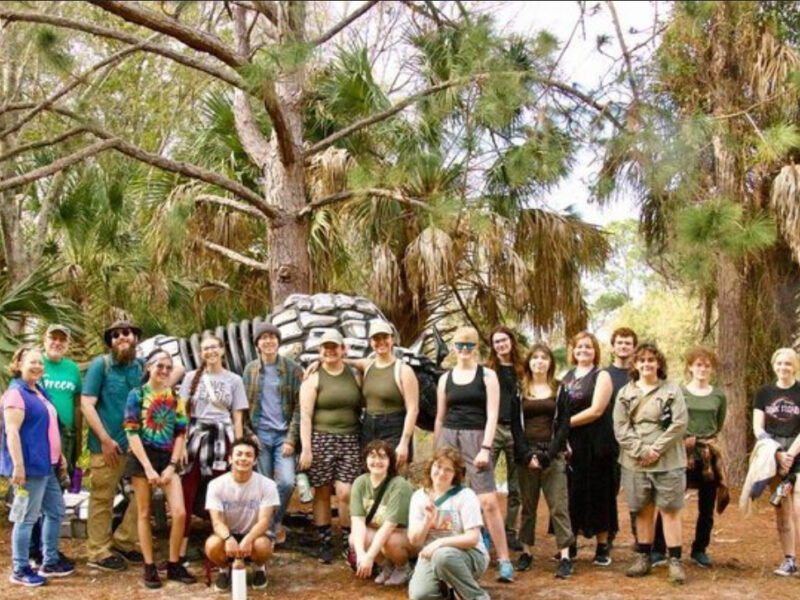Pictured above: A concerning number of fish carcasses are pushed into St. Pete’s North Shore Park, as this year’s severe Red Tide continues to spread along Florida’s east coast.
Courtesy of Martin Frobisher (Tampa Bay Times).
By Brianna Madden
Every year, Tampa Bay beachgoers dread red tide season. However, many do not truly understand what takes our beaches hostage during prime vacation time.
When most Floridians hear the words “red tide” they picture closed beaches, dead fish and canceled vacations. But red tide is much more than a major inconvenience, it’s a natural phenomenon.
What we call “red tide”, is actually large algae blooms that release toxins into coastal waters around the world. Florida’s west coast, including Tampa Bay, is plagued by Karenia Brevis (K. Brevis), a single-celled dinoflagellate species that lives in the Gulf of Mexico year-round.
K.Brevis exists up to 40 miles offshore at harmless levels near the seafloor. During late summer and early fall, Earth’s rotation causes upwelling, a natural process where deep, cold, nutrient-rich water is brought to the surface by strong currents. Caught in the currents are small amounts of K. Brevis.
The summer heat, high levels of sunlight and newly available nutrients encourages the growth of the algae, creating an algae bloom.
A large K. Brevis bloom is the beginning of what we know as red tide.
As currents and strong winds shift the bloom closer to shore, the algae releases brevetoxins, neurotoxic compounds produced by K.Brevis, at highly concentrated and deadly levels.
The toxins attack the central nervous system of fish causing their entire bodies to dysfunction, leaving them dead. The currents wash the fish carcasses onto the shore, making the start of red tide season known.
However, the mass murder of fish is not the only consequence the environment suffers.
The algae can be hit by strong waves, breaking open the cells and releasing toxins into the air. While severe cases are rare, if high levels of the toxins are inhaled by humans, mild respiratory irritation can occur. Therefore, many beaches close, and people with respiratory conditions are advised to avoid red tide areas.
The Florida Fish and Wildlife Conservation Commission expands on health concerns regarding red tide, including Neurotoxic Shellfish Poisoning (NSP). People suffer from NSP after consuming shellfish that contain brevetoxins. This includes bivalve mollusks, like clams, oysters and scallops, and other filter feeders.
During red tide, it is safe to eat shellfish and other seafood purchased from restaurants and stores, since they are tested before sold. However, recreational harvesting in red tide areas is illegal. It is important to note that red tide does not affect freshwater habitats, and it is safe to harvest and consume animals in areas with a very low salinity.
While it is safe to swim during red tide season, it is possible to experience irritation of the skin and eyes, and it is imperative to rinse off immediately. Pet owners are also advised to keep their pets indoors and out of the water as much as possible.
Along with major health issues, Florida’s economy also suffers. Red Tide causes decreases in tourism, home values and commercial fishing, while increasing costs of shoreline and water management.
Scientists have been working for years to control K. Brevis.
In a recent USF survey, 85 percent of Floridians supported regulating the use of agricultural fertilizers to assist with red tide. However, there is more evidence to dispute the negative effect fertilizers have on red tide than there is to support it.
So far, it is impossible to kill K. Brevis without harming the rest of the environment. While scientists continue to look for ways to control red tide, they mainly monitor and track its progression.
Due to red tide’s unpredictable behavior, organizations like the Florida Fish and Wildlife Conservation Commission and the National Oceanic and Atmospheric Administration use technology to track blooms and determine their impacts. To keep the public informed and safe, sample maps are available online to show the progression of red tide in the previous eight days.
As scientists continue to conduct research on K. Brevis, they hope to find new ways to lessen its effect on the environment. But it seems like our beaches will have to endure the onslaught, that is red tide, for many years to come.



